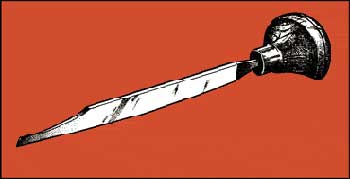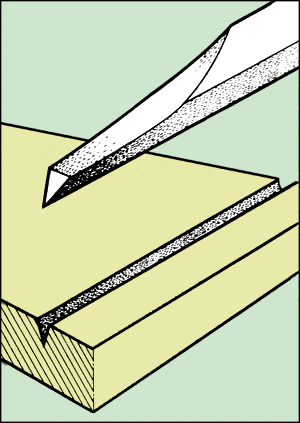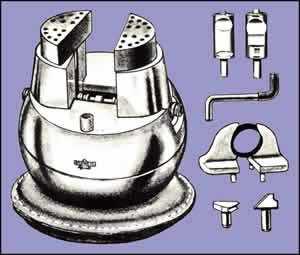The Hand Engraving Process

Hand engravers use a tool called a graver. It is a piece of flat rectangular steel rod with one end sharpened and the other end finished with a rounded wood knob that is cradled in the palm of the hand.

The graver is pushed along the surface of the metal cutting an angled groove. This creates a crisp line that is bright and shiny. Gravers can have different shapes on the cutting end for a variety of decorative techniques. The shank of the graver can also be bent to work on the inside of rings.
Hand engraving is different from other decorative techniques in the sharpness of the lines and its permanence. Rings engraved in the 1500s still have clear designs. Machine engraving cannot cut as deeply as the hand technique. Stamping and etching are not as sharp. Lasers and die cutting can also be used on metal but the results look machined rather than finely crafted.

An engraver's block is used to hold many types of jewelry and silverware for engraving. Pins with different types of heads are inserted the the holes in the split, flat top of the block. The pins are shown slightly enlarged here. The two top halves can be screwed closer together while the pins hold the piece to be engraved.

Eric Margry is shown here engraving the bottom of a cup using an engraver's block. If he were working on a ring, most of the action would be covered up. He begins with drawing the design onto whatever surface will be engraved. A special white paint lets him lay out a visible pattern. Details are especially important in this type of work and he is adept at condensing designs and adapting them to the scale of jewelry and small objects.
Continue reading to learn about techniques specific to Family Crest Rings or if you are interested in monograms and other designs, then go to other engraving work.

Hand engraving Family Crest Rings is a specialty of Eric Margry. Few are proficient in this time-consuming craft. Heraldic symbols that used to cover a Knight's shield must be reduced to the size of a ring. In the Middle Ages, a visual system was set up to represent the colors of the Coat of Arms with patterns. On this emblem, the dots on the mantle (the rippling fabric) mean it's gold. On the shield, the vertical stripes are red. In the Middle Ages, these rings were always engraved in reverse so that the Family Crest read properly when pressed into sealing wax to authenticate a document.

Wax imprints from a true Family Crest ring are 3-dimensional. This is acheived by cutting into the metal at different depths. The animals or objects on the shield are engraved the deepest so they are raised on the shield in wax. The shield is engraved so it will be set off from the background. The helmet is engraved concave so it appears rounded and slightly in front of the shield surface. The mantle varies in depth as cloth would twist and turn. This complex layering can only be achieved with hand engraving. A family crest ring that is executed in the opposite way (with the parts raised instead of cut in) cannot be used to press into the wax and so is not in the true tradition of family crest rings. Rings cut with lasers are not traditional since they cannot have different levels.
Eric Margry follows the standards and methods that were established during ancient times. His old world craftsmanship results in an heirloom worthy of royalty.
